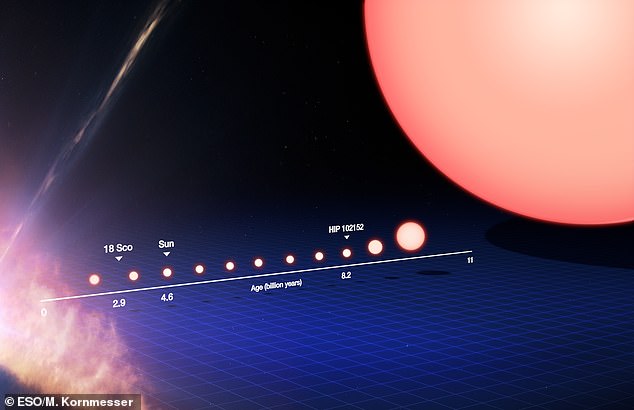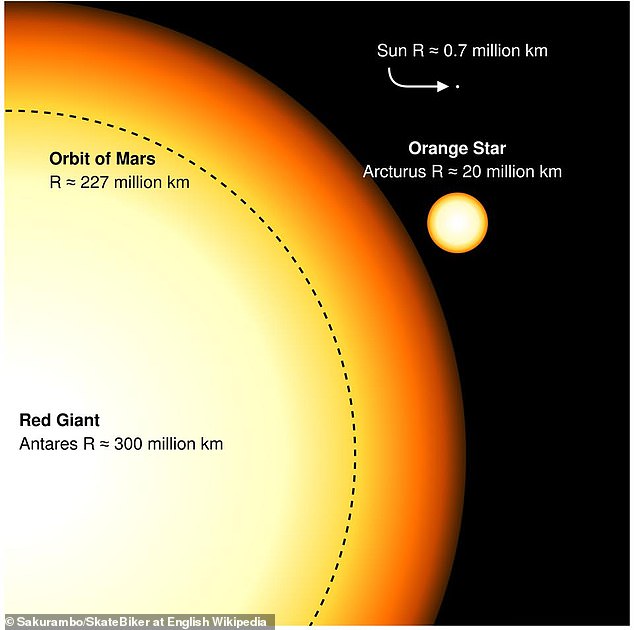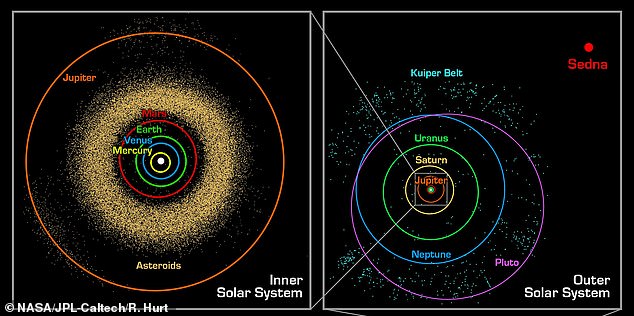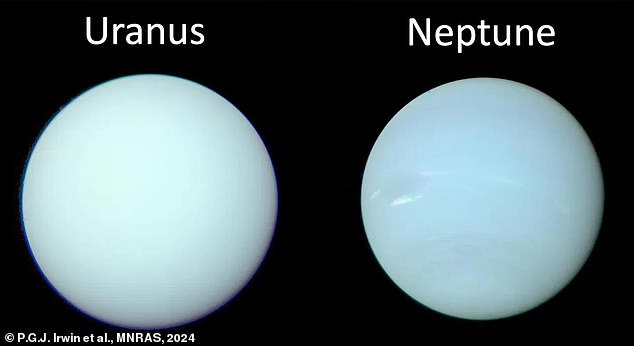How the World Will End: Terrifying graphics reveal the gruesome fate of each planet as the sun dies
From the AI apocalypse to outright nuclear war, it seems like there’s an almost endless list of things that could cause the end of the world.
But if this terrifying fate befalls us, there is one doomsday scenario that Earth cannot avoid.
A terrifying graph shows how the Sun will grow into a huge ‘red giant’ star, growing so big it will spell the end of the solar system as we know it.
While this may seem completely terrifying, there’s no need to worry just yet.
Dr. Edward Bloomer, senior astronomer at Royal Observatory Greenwich, said: ‘There is probably somewhere in the region of 5 billion years to go before the red giant phase begins for the Sun. So we still have some time!’
This image reveals the gruesome fate of all the planets in the solar system as the Sun dies and turns into a huge red dwarf star

In about five to 5.5 billion years, the Sun will run out of helium and begin to expand outward, cooling and becoming a red giant. This artist’s impression shows an exoplanet as it is pulled into the heat of its own star
Our sun, like all stars, is essentially a giant nuclear furnace that smashes helium atoms together under the influence of gravity.
This immense gravity keeps the eight planets and countless other objects in the solar system in orbit around Earth.
Meanwhile, the energy generated by nuclear fusion is radiated into the universe as heat, creating a habitable zone that extends from just beyond Venus to the orbit of Mars.
Dr. However, Bloomer told MailOnline that this will all change eventually.
In about five to 5.5 billion years, the sun will turn into a red giant.
‘This mainly happens when the sun runs out of hydrogen to fuse in its core,’ explains Dr Bloomer.

This diagram traces the life of a Sun-like star from its birth through its evolution into a red giant. On the left, the star starts as a dust cloud and progresses through the main sequence stages until it becomes a red giant on the right
When our sun eventually runs out of hydrogen, its core will begin to collapse under the pull of its own gravity.
As the outer layers collapse inward, the resulting pressure and heat will become so intense that these layers will fuse helium atoms into carbon.
The resulting burst of energy will cause the sun to expand to hundreds of times its original size and cool from white to red-hot.
Mr. Bloomer explains that while this process is “not quite like flipping a switch,” it will inevitably lead to the destruction of the solar system.

It’s difficult to estimate how big the Sun will become, but at its high end it could reach a diameter of up to 300 million kilometers, which is the same size as the red giant Antares (pictured)
Currently, the Sun has a diameter of about 865,000 miles (1.4 million kilometers).
But if it becomes a red giant, it could swell to more than 200 times this size, with a diameter of up to 300 million kilometers.
When this happens, the inner planets – Mercury and Venus – will be pulled towards the sun and destroyed.
Dr. However, Bloomer said, “The exact size of the red giant is not precisely known, so Earth is in an interesting position.”
At a distance of 93 million miles (148.22 million km) from the sun, it may seem as if Earth is on the cusp.
But 300 million kilometers is the absolute upper limit for the sun’s growth, and this size may not become nearly that large.
Dr. Bloomer said: ‘At the higher end of the possible sizes, the Earth could be completely swallowed up by the Sun, and that would be the end of it. It should not be consumed at the bottom.”

When the Sun swells into a red giant, Mercury and Venus will be swallowed up by its expansion and the inner planets (left) will be stripped of their atmosphere. The outer planets (right) will be less affected by the change
But even if the sun doesn’t swallow the Earth whole, that’s still not good news.
Dr. Bloomer said: ‘Earth’s surface temperature will mean the atmosphere will be blown away and the oceans will be boiled away. ‘
He adds, “The ‘Earth’ that remains would be, at best, a radiation-irradiated ball of lifeless rock.”
The outer planets will not escape unscathed, as Mars, Jupiter and Saturn will all be blown away by the intense heat of the growing red giant.
If the sun gets big enough, it can burn away through a process called “photoevaporation,” in which stellar emissions strip away surrounding gases.
Dr. However, Bloomer explains that some models predict that Saturn could suddenly find itself in the center of the Sun’s new habitable zone.
He said: ‘Some models suggest it could be quite temperate around Saturn’s distance from the Sun. We can’t live on Saturn, but maybe on the moon Titan?
‘It is currently home to a thick, unbreathable atmosphere and lakes of liquid ethane and methane due to its extremely low temperatures, but trying to find out what would happen there as it warms up is an area of ongoing research.’

This image shows the Ring Nebula, which formed when a dying star expelled the last of its material into space. The same fate will eventually befall our sun
Eventually, in about seven billion years, the Sun will run out of energy altogether and begin to drift its outer layers into space, leaving behind a planetary nebula.
These enormous, ring-shaped structures form when dying stars eject most of their remaining material before becoming a hot white dwarf star.
Last year, scientists used the James Webb Space Telescope to capture images of Messier 57, or the Ring Nebula, giving us an idea of what our Sun will one day become.
And in these final stages, the Sun will complete its transformation of the solar system as it removes the outer planets from its orbit.
If the Sun loses 50 percent of its mass during this process, the forces will be so strong that Uranus and Neptune will simply be wiped out of the solar system.

If the Sun loses more than 50 percent of its mass when it becomes a planetary nebula, the force will throw Uranus and Neptune (pictured) into space
Finally, as for the asteroid belt and the Oort Cloud that also orbit the Sun, the extent to which they will be affected depends on their distance.
As the sun grows to its final gigantic size, objects in the asteroid belt can be heated to such extreme temperatures that frozen gases and water will sublimate away, leaving only metallic cores behind.
However, in the Oort Cloud – a vast expanse of rocky material located between 0.079 and 1.58 light-years from the Sun – very little will change.
“In a sense, they may not notice as much because they’re just too distant,” says Dr. Bloomer.
‘However, depending on things like changes in the solar system’s angular momentum caused by the expansion of the Sun, places like the Oort Cloud could be slightly disturbed, and the orbits of objects in that vast region could be altered.
“Overall, though, it probably won’t be as transformative as the effects on the inner solar system.”
